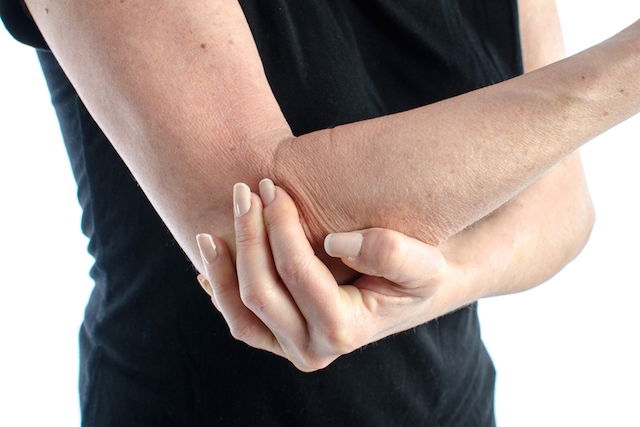Elbow pain is a very common symptom in people who lift weights and can particularly be felt after a triceps workout. It is also reported by those who engage in intense sports, like crossfit, tennis or golf.
Normally, elbow pain is not a serious condition, but it can cause great discomfort. The elbow is a joint that is used in almost all arm and hand movements.
Elbow pain is treatable, but in most cases, you are advised to follow up with your doctor or an orthopedic surgeon about the most appropriate treatment. Treatment may involve medications and physiotherapy.

Causes of elbow pain
Elbow pain can occur for the following reasons:
1. Epicondylitis
This condition is characterized by inflammation of the elbow tendons, also known as the lateral or medial tendons. Inflammation that occurs in the inner elbow is also referred to as “golfer’s elbow” while inflammation noted in the outer elbow is “tennis elbow.”
Epicondylitis can cause pain with arm movement as well as hypersensitivity to palpation of the elbow. Pain generally worsens when straightening the arm or when flexing it. It is usually felt after playing sports or working out.
What to do: To relieve elbow pain, you should rest the affected arm, apply cold compresses to the area, and take analgesic medications, like acetaminophen. Some people may benefit from physiotherapy as well.
2. Elbow bursitis
This condition is characterized by an inflammation of the tissue that cushions the elbow joint. This pain is felt at the back of the elbow, and can occur when the elbow is in frequent contact with hard surfaces (like a table). It is commonly found in students and in patients with a history of gout or rheumatoid arthritis.
What to do: To treat this pain, you should rest the affected arm, apply cold compresses to the area, and take anti-inflammatory medications, like ibuprofen, as prescribed by your doctor. Some people may benefit from physiotherapy as well.
3. Elbow arthritis
This condition is characterized by the breakdown and inflammation of the elbow joint. It can cause pain and swelling in the area, and is commonly seen in older adults.
What to do: Treatment of pain from elbow arthritis should be managed by a family doctor or orthopedic surgeon. It normally involves the use of anti-inflammatories (like naproxen) as well as physiotherapy.
4. Arm fracture
A fracture can occur due to direct trauma from accidents, falls or a blow to the bony areas around the elbow. It can affect the upper arm and forearm.
What to do: If the elbow pain does not resolve with analgesic medications or cold compresses, and you suspect your arm is fractured, you should proceed to an emergency room for immobilization and treatment.
5. Ulnar nerve compression
This type of nerve compression is more frequently noted after orthopedic surgery. It is associated with symptoms like arm tingling that radiates to the ring or pinky finger, weakness and difficulty moving the hands and fingers.
What to do: Mild nerve compression can be managed with physiotherapy as directed by an orthopedic surgeon, however more severe cases may require surgery to reposition the affected nerve.
6. Synovial plica syndrome
Synovial plica syndrome is characterized by the plica in the elbow (which is a fold in the synovial membrane) that gets caught inside the elbow joint. The fold can start to become thicker from being stuck, causing pain that is felt with stretching the arm with your palm facing down. An MRI is the only way to visualize the increased plica size (which should be under 3mm).
What to do: In addition to applying anti-inflammatory ointments, physiotherapy is recommended.
When to see a doctor
You should see a doctor if the elbow pain emerges very suddenly, especially if it is felt with chest pain or when:
- The pain occurs with a fever
- Swelling and pain progressively get worse
- Pain is felt even when resting
- Pain does not resolve with rest and analgesics
In these cases, you should see an orthopedic surgeon for further assessment. Once the underlying cause is identified, appropriate treatment can be initiated.
